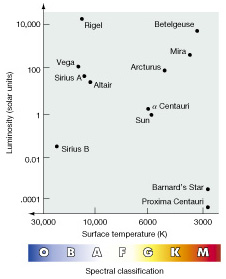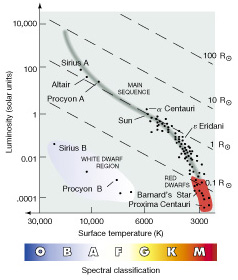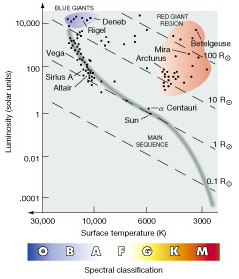Pre-lab 9: Stars and the HR Diagram
The Hertzsprung-Russell Diagram
Figure 10.12 plots luminosity versus temperature for a few well-known stars. A figure of this sort is called a Hertzsprung-Russell diagram, or H–R diagram, after Danish astronomer Ejnar Hertzsprung and U.S. astronomer Henry Norris Russell, who independently pioneered the use of such plots in the second decade of the twentieth century. The vertical luminosity scale, expressed in units of solar luminosity (3.9 x 1026 W) extends over a large range, from 10-4 to 104. The Sun appears right in the middle of the luminosity range, at a luminosity of one. Surface temperature is plotted on the horizontal axis, although in the unconventional sense of temperature increasing to the left, so that the spectral sequence O, B, A, reads left to right.
|
Figure 10.12 H-R Diagram of Well-Known Stars A plot of luminosity against surface temperature (or spectral class), known as an H-R diagram, is a useful way to compare stars. Plotted here are the data for some stars mentioned earlier in the text. The Sun, of course, has a luminosity of 1 solar unit. Its temperature, read off the bottom scale, is 5800 K—a G-type star. Similarly, the B-type star Rigel, at top left, has a temperature of about 15,000 K and a luminosity more than 10,000 times that of the Sun. The M-type star Proxima Centauri, at bottom right, has a temperature of 3000 K and a luminosity less than 1/10,000 that of the Sun. |
The Main Sequence
The few stars plotted in Figure 10.12 give little indication of any particular connection between stellar properties. However, as Hertzsprung and Russell plotted more and more stellar temperatures and luminosities, they found that a relationship does in fact exist. Stars are not uniformly scattered across the H–R diagram. Instead, most are confined to a fairly well-defined band stretching diagonally from top left (high-temperature, high-luminosity) to bottom right (low-temperature, low-luminosity). In other words, cool stars tend to be faint (less luminous) and hot stars tend to be bright (more luminous). This band of stars spanning the H-R diagram is known as the main sequence. Figure 10.13 is an H-R diagram for stars lying within 5 pc of the Sun. Note that most stars in the solar neighborhood lie on the main sequence.
The surface temperatures of main-sequence stars range from about 3000 K (spectral class M) to more than 30,000 K (spectral class O). This temperature range is relatively small—only a factor of 10. In contrast, the observed range in luminosities is very large, covering eight orders of magnitude (that is, a factor of 100 million), from 10-4 to 104 times the luminosity of the Sun.
|
|
|
|
Figure 10.13 H-R Diagram of Nearby Stars Most stars have properties within the shaded region of the H–R diagram known as the main sequence. The points plotted here are for stars lying within about 5 pc of the Sun. Each dashed diagonal line corresponds to a constant stellar radius, so that stellar size can be indicated on the same diagram as stellar luminosity and temperature. |
|
Using the radius–luminosity–temperature relationship (L µ R2T4), astronomers find that stellar radii also vary along the main sequence. The faint, red M-type stars in the bottom right of the H-R diagram are only about 1/10 the size of the Sun, whereas the bright, blue O-type stars in the upper left are about 10 times larger than the Sun. The dashed lines in Figure 10.13 represent constant stellar radius, meaning that any star lying on a given line has the same radius, regardless of its luminosity or temperature. Along a constant-radius line, the radius–luminosity–temperature relationship implies
Luminosity µ Temperature4
By including such lines on our H-R diagrams, we can indicate stellar temperatures, luminosities, and radii on a single plot.
At the top end of the main sequence, the stars are large, hot, and very luminous. Because of their size and color, they are referred to as blue giants. The very largest are called blue supergiants. At the other end, stars are small, cool, and faint. They are known as red dwarfs. Our Sun lies right in the middle.
Figure 10.14 shows an H-R diagram for a different group of stars—the 100 stars of known distance having the greatest apparent brightness, as seen from Earth. Notice that here there are many more stars at the upper end of the main sequence than at the lower end. The reason for this excess of blue giants is simple—we can see very luminous stars a long way off. The stars shown in Figure 10.14 are scattered through a much greater volume of space than those in Figure 10.13, and the Figure 10.14 sample is heavily biased toward the most luminous objects. In fact, of the 20 brightest stars in the sky, only six lie within 10 pc of us. The rest are visible, despite their great distances, because of their high luminosities.
If very luminous blue giants are overrepresented in Figure 10.14, low-luminosity red dwarfs are surely underrepresented. In fact, no dwarfs appear on this diagram. This absence is not surprising, because low-luminosity stars are difficult to observe from Earth. In the 1970s, astronomers began to realize that they had greatly underestimated the number of red dwarfs in our galaxy. As hinted at by the H-R diagram in Figure 10.13, which shows an unbiased sample of stars in the solar neighborhood, red dwarfs are actually the most common type of star in the sky. They probably account for upward of 80 percent of all stars in the universe. In contrast, O- and B-type supergiants are extremely rare—only about one star in 10,000 falls into this category.
The White-Dwarf and Red-Giant Regions
Some of the points plotted in Figures 10.12 to 10.14 clearly do not lie on the main sequence. One such point in Figure 10.12 represents Sirius B, the white dwarf. Its surface temperature (24,000 K) is about four times that of the Sun, but its luminosity is only 0.04 times the solar value. A few more such faint bluish-white stars can be seen in the bottom left-hand corner of Figure 10.13, in the white-dwarf region.
Also shown in Figure 10.12 is Mira, with a surface temperature (3000 K) about half that of the Sun, but its luminosity is some 400 times greater than the Sun’s. Another point represents Betelgeuse, the ninth brightest star in the sky, a little hotter than Mira, and more than 30 times more luminous. The upper right-hand corner of the H-R diagram (marked on Figure 10.14), where these stars are found, is called the red-giant region (and Supergiant region). No red giants are found within 5 pc of the Sun (Figure 10.13), but many of the brightest stars seen in the sky are in fact red giants (Figure 10.14). Red giants are relatively rare, but they are so bright that they are visible to very great distances. They form a third distinct class of stars in the H-R diagram, very different in their properties from both main-sequence stars and white dwarfs.





